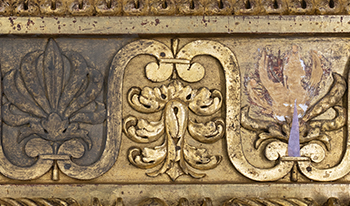
This paper will present the story of a collaborative project between the Imaging Department and the Paintings Conservation Department of the Metropolitan Museum of Art to use 3D imaging technology to restore missing and broken elements of an intricately carved giltwood frame from the late 18th century.

Tailored magnetic nanocomposites have applications ranging from communications technologies to medical devices. Using a novel 3D fabrication technique that combines thermal inkjet and powder bed fusion print technologies, magnetic composites were fabricated by jetting magnetic nanoparticle containing ink into a polymer powder bed and then heat fusing the ink/polymer matrix. The goals were to demonstrate the feasibility of nanocomposite fabrication with controllable magnetic properties by varying the volume fraction of magnetic ink jetted into the polymer as well as to experimentally validate the effective medium theory based model developed to predict the permeability of the composites as a function of its magnetic particle concentration. As expected, magnetic susceptibility and saturation magnetization were seen to increase with the volume fraction of magnetic particles in the composites.

Realistic appearance reproduction is of great importance in 3D printing’s applications. Halftoning as a necessary process in printing has a great impact on creating visually pleasant appearance. In this article, we study the aspects of adapting and applying Iterative Method Controlling Dot Placement (IMCDP) to halftone three-dimensional surfaces. Our main goal is to extend the 2D algorithm to a 3D halftoning approach with minor modifications. The results show high-quality reproduction for all gray tones. The 3D halftoning algorithm is not only free of undesirable artifacts, it also produces fully symmetric and wellformed halftone structures even in highlight and shadow regions.

Designers need to specify the colors for their 3D objects in form of sRGB values, but, given the limitations of the color 3D printing process, they have no idea how those colors chosen on a screen will look once printed in 3D. In addition, HP Inc. wants to showcase the color capabilities of our 3D color printing systems in an effective way. This paper describes an aesthetically pleasing tool to effectively showcase the color capabilities of our color 3D printing systems. It is also a reference color system that enables designers 1) to select colors that are achievable with our printing systems, 2) to interactively composite color palettes for their 3D design and 3) to get the desired printed color in a time and cost-efficient way that minimizes iterations. The system itself consists of a series of subobjects where each sub-object shows how a color looks like when manufactured in different surface orientations. It can be disassembled and used for compositing color palettes for 3D objects, and it is also designed to be manufactured and cleaned fully assembled, showcasing the power of 3D printing.

With the advent of more sophisticated color and surface treatments in 3D printing, a more robust system for previewing these features is required. This work reviews current systems and proposes a framework for integrating a more accurate preview into 3D modelling systems.

3D printing is increasingly used for manufacturing final parts. The look and feel of final parts can be important, especially if they are intended for visible or wearable applications. We find that after parts are printed and cleaned, their aesthetic qualities can benefit from a variety of finishing processes. In this paper, we describe our post-processing work, largely for parts printed using HP’s Multi-Jet Fusion (MJF), and with an emphasis on techniques that scale sufficiently to be useful in manufacturing workflows. We detail our efforts using vibratory tumblers for smoothing, and coatings and dyes for visual appearance, as well as how we have used some of these techniques and methods for specific wearables.